Key Points
- The Trump administration wants to quadruple our use of carbon-free nuclear power output by 2050.
- Most American climate nonprofits oppose nuclear power, claiming it is dirty and dangerous, but the facts say otherwise.
- France has generated more than 60 percent its electricity from nuclear since the mid-1980s.
- The U.S. Navy has operated hundreds of nuclear vessels—including submarines—for 70 years and has an excellent safety record.
The Trump administration wants to quadruple American nuclear power output by 2050. There is no physical challenge to this goal, as France—now the world’s seventh largest economy—launched an aggressive buildout of nuclear power in 1974, based on American nuclear reactor designs. By 1985, France was already generating almost two-thirds of its electricity from uranium.
French nuclear is so successful that it powers other nations. According to the World Nuclear Association, “France is the world’s largest net exporter of electricity due to its very low cost of generation.”
Nuclear power emits no carbon emissions. Of the planet’s 10 largest economies, France emits less carbon dioxide per unit of GDP than all of them.
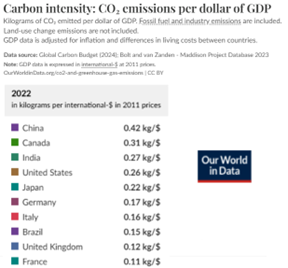
Ironically, the biggest challenge to bringing this energy success to the United States is political. Nearly all of the largest American climate nonprofits oppose nuclear energy.
For example, the World Wildlife Fund (WWF) opposed the European Union’s 2021 proposal to add nuclear as an option within Europe’s carbon reduction goals. In a news release, the WWF lumped together and denounced “fossil fuels” and nuclear power as equally “unsustainable.”
The Sierra Club has logged decades of opposition to nuclear power. A “Nuclear Free Future” page on the Sierra Club website declares the group is “unequivocally opposed to nuclear energy” because it is “uniquely dangerous” and “no solution to climate change.”
Within the past decade, even nonprofits such as the California Teachers Association and the NAACP have co-signed or adopted statements opposing the use of nuclear energy.
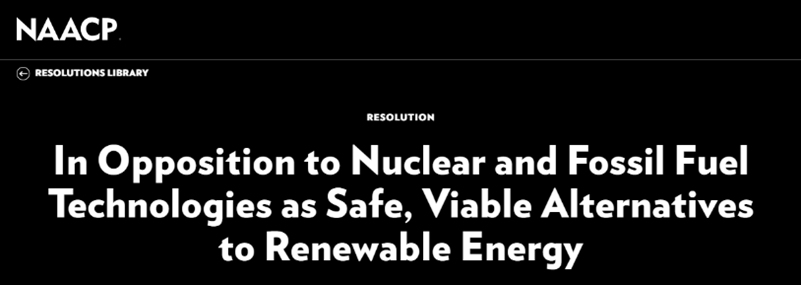
The combined annual revenue of the hundreds of nonprofits known to be opposed to nuclear power exceeds $2.5 billion. This formidable opposition has 4,100 percent more annual revenue than the Nuclear Energy Institute, the industry-sponsored nonprofit that promotes nuclear power development.
What Are They Opposed To?
The United States produced 775.4 terawatt-hours (TWh) of electricity from nuclear reactors in 2023. Americans are already—by far—the world’s largest producer of the only form of carbon-free electricity that is both reliable and scalable. American nuclear power in 2023 exceeded the combined output of the second and third largest nuclear-energy nations: China (434.7 TWh) and France (335.7 TWh).
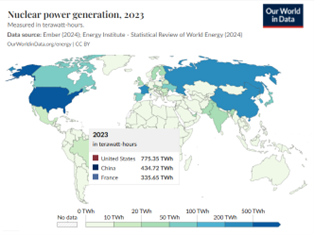
Nuclear energy was also America’s largest single source of carbon-free power in 2023, nearly equaling the combined output of all five electricity sources the Department of Energy classifies as “renewables.” Nuclear provided 18.6 percent of total American electricity in 2023, while wind added 10.2 percent and solar just 3.9 percent.
But even so, nuclear fuel still accounts for less than one-fifth of total American electricity production.
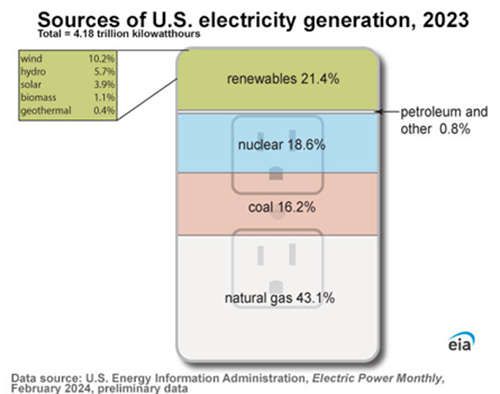
The U.S. Department of Energy also reports: “Nuclear Power is the Most Reliable Energy Source and It’s Not Even Close.” With a capacity factor of 92.5 percent, an American nuclear reactor is almost always running at full output and has little need for downtime.
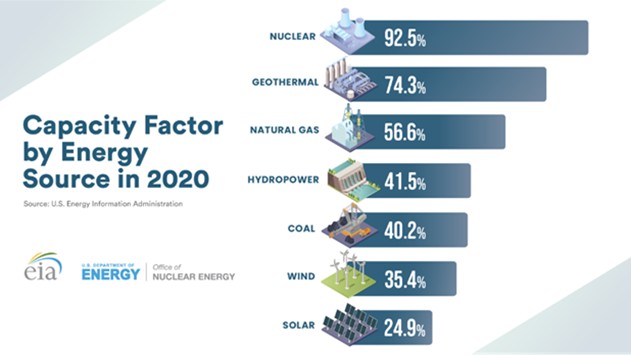
Explaining the extremely low reliability of wind and solar, the Department of Energy report notes the following:
Renewable plants are considered intermittent or variable sources and are mostly limited by a lack of fuel (i.e. wind, sun, or water). As a result, these plants need a backup power source such as large-scale storage (not currently available at grid-scale)—or they can be paired with a reliable baseload power like nuclear energy.
With an economy that is nine times larger than France, the United States has a lot of room, demand, and thus economic capacity to dramatically increase its own (and the world’s) use of carbon-free nuclear power. According to the U.S. Department of Energy, there will be no shortage of uranium to do the job.
“Uranium is a common metal found in rocks all over the world,” reports the Energy Department. “Economically recoverable uranium reserves are located in the western United States, Australia, Canada, Central Asia, Africa, and South America.”
According to a Scientific American analysis, the current known reserves of uranium are enough to power up current nuclear energy consumption for 200 more years.
Looking at technological advancements just over the horizon, the report also estimated that recovering uranium from sea water would add 60,000 years to the current use rate of nuclear power and that breeder reactors (a nifty technology that creates nuclear fuel as it generates electricity) would tack on 30,000 more years.
If that’s all we had, then we would have a thousand centuries of uranium to work with, which is probably enough time for humanity to find an alternative.
But that’s not all there is. At present, we already know how to develop other abundant nuclear reactor fuels, such as thorium. And we have the theoretical possibility of fusion reactors, which would be a functionally limitless source of power.
As a practical matter, our nuclear future should last forever—or at least as long as we need it.
But Is It Dirty and “Uniquely Dangerous”?
In a very narrow, literal sense, nuclear power is dangerous. But so are all other sources of energy production, going back to the first harnessing of fire.
Most objective sources dispute that nuclear energy is “uniquely dangerous,” as claimed by nonprofits such as the Sierra Club. Compiling the work of many such sources, Our World in Data has generated a report on the relative safety of our sources of energy based on “estimated number of deaths they cause per unit of electricity.”
“Nuclear energy,” they concluded, “results in 99.9% fewer deaths than brown coal, 99.8% fewer than coal, 99.7% fewer than oil, and 97.6% fewer than gas.” They concluded nuclear power generation presents functionally the same danger level as wind turbines and solar panels.
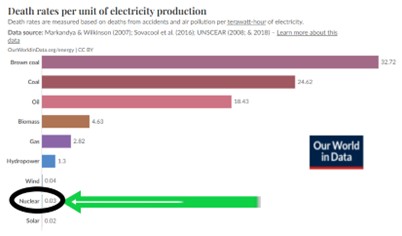
The negative perceptions of nuclear safety, according to Our World in Data, “are often sparked by memories of two nuclear accidents: the Chernobyl disaster in Ukraine in 1986 and Fukushima in Japan in 2011.”
In both cases, the authors examined all likely fatalities over time, from the immediate deaths caused by the two accidents to the estimated long-term cancer deaths caused by radiation exposure.
They concluded the “confirmed death toll from Chernobyl is less than 100” and that the “true death toll is in the range of 300 to 500, based on the available evidence.”
Virtually all recorded fatalities in the history of the nuclear energy industry are from this one incident, supervised by the Soviet Union’s corrupt communist system that no longer exists and couldn’t even make reliable automobiles when it did.
Notably, the American and other world navies have been running hundreds of warships on nuclear reactors since 1955—including submarines. The U.S. Navy has never had a major nuclear power safety incident. The same cannot be said of the earliest nuclear navy efforts from the Soviet Union.
For Fukushima, the Our World in Data team found one (1) long-term fatality from radiation exposure and zero deaths caused from heat and radiation during the initial accident (though there were 40-50 people harmed by burns and other injuries and fatalities from the tsunami evacuation.)
As to the “dirty” allegation, the U.S. Department of Energy reports that storing spent nuclear fuel requires only tiny scraps of land and that this so-called “nuclear waste” isn’t really waste, because it could be recycled into new fuel if we chose to do so.
“All of the used nuclear fuel produced by the U.S. nuclear energy industry over the last 60 years could fit on a football field at a depth of less than 10 yards!” claimed the report. “That waste can also be reprocessed and recycled, although the United States does not currently do this.”
Rather than an “inherently dirty,” “uniquely dangerous,” and “unsustainable” energy source, as alleged by hundreds of America’s richest climate policy nonprofits, nuclear power is instead very safe (relative to other energy systems), exceptionally clean, and the most abundant and reliable energy option that we have.












